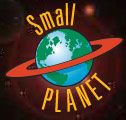Small Planet Communications, Inc. + 15 Union Street, Lawrence, MA 01840 + (978) 794-2201 + Contact
Discover our Solar System
Although we know a lot about the planets in our solar system, we have much more to learn. Scientists want to know more about the composition of the planets and their atmospheres. Some people wonder whether life ever existed on these lonely outposts.
Return to Solar System home.


